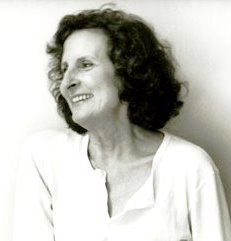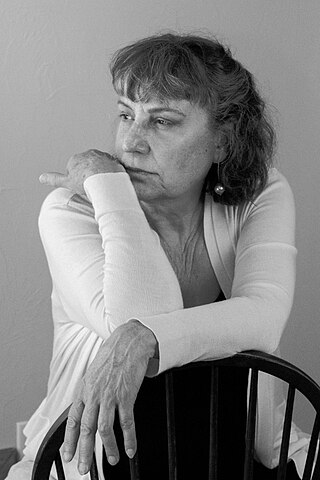Related Research Articles

Mercier Philip "Merce" Cunningham was an American dancer and choreographer who was at the forefront of American modern dance for more than 50 years. He frequently collaborated with artists of other disciplines, including musicians John Cage, David Tudor, Brian Eno, and graphic artists Robert Rauschenberg, Bruce Nauman, Andy Warhol, Roy Lichtenstein, Frank Stella, and Jasper Johns; and fashion designer Rei Kawakubo. Works that he produced with these artists had a profound impact on avant-garde art beyond the world of dance.
Contact improvisation is a form of improvised partner dancing that has been developing internationally since 1972. It involves the exploration of one's body in relationship to others by using the fundamentals of sharing weight, touch, and movement awareness. It has evolved into a broad global community of social dancing around "jams" characterized by their welcoming attitude towards newcomers to dance, as well as seasoned practitioners, and is often found overlapping with ecstatic dance communities.
Dance improvisation is the process of spontaneously creating movement. Development of movement material is facilitated through a variety of creative explorations including body mapping through levels, shape and dynamics schema.
Judson Dance Theater was a collective of dancers, composers, and visual artists who performed at the Judson Memorial Church in Greenwich Village, Manhattan New York City between 1962 and 1964. The artists involved were avant garde experimentalists who rejected the confines of Modern dance practice and theory, inventing as they did the precepts of Postmodern dance.
Postmodern dance is a 20th century concert dance form that came into popularity in the early 1960s. While the term "postmodern" took on a different meaning when used to describe dance, the dance form did take inspiration from the ideologies of the wider postmodern movement, which "sought to deflate what it saw as overly pretentious and ultimately self-serving modernist views of art and the artist" and was, more generally, a departure from modernist ideals. Lacking stylistic homogeny, Postmodern dance was discerned mainly by its anti-modern dance sentiments rather than by its dance style. The dance form was a reaction to the compositional and presentational constraints of the preceding generation of modern dance, hailing the use of everyday movement as valid performance art and advocating for unconventional methods of dance composition.

Yvonne Rainer is an American dancer, choreographer, and filmmaker, whose work in these disciplines is regarded as challenging and experimental. Her work is sometimes classified as minimalist art. Rainer currently lives and works in New York.

Trisha Brown was an American choreographer and dancer, and one of the founders of the Judson Dance Theater and the postmodern dance movement. Brown’s dance/movement method, with which she and her dancers train their bodies, remains pervasively impactful within international postmodern dance.
The Grand Union was an improvisational dance group based in New York City from 1970 to 1976. It grew out of Yvonne Rainer dance company, and her piece Continuous Project - Altered Daily. Rainer's sole authority as choreographer began to slip in early 1970 when the dancers, at her invitation, began to bring in their own materials for the piece. By late 1970, new members had joined the group and the materials were improvised to a much greater extent. The company, which was still often billed as "Yvonne Rainer and Dancers" in the beginning, chose "The Grand Union" as a name to avoid any obvious associations with dance to inoculate themselves against charges that what they were doing was not properly dance. To avoid problems with the supermarket chain of the same name, the group used the legal name "Rio Grand Union".

Steve Paxton is an experimental dancer and choreographer. His early background was in gymnastics while his later training included three years with Merce Cunningham and a year with José Limón. As a founding member of the Judson Dance Theater, he performed works by Yvonne Rainer and Trisha Brown. He was a founding member of the experimental group Grand Union and in 1972 named and began to develop the dance form known as Contact Improvisation, a form of dance that utilizes the physical laws of friction, momentum, gravity, and inertia to explore the relationship between dancers.
Lillian Elaine Summers was an American choreographer, experimental filmmaker, and intermedia pioneer. She was a founding member of the original workshop-group that would form the Judson Dance Theater and she significantly contributed to the interaction of film and dance, as well as the expansion of dance into other related disciplines, such as visual art, film, and theater. She fostered the expansion of performing dance in new, often outdoor locations. Her movement approach Kinetic Awareness offers a comprehensive perspective on human movement and dance.

David Gordon was an American dancer, choreographer, writer, and theatrical director prominent in the world of postmodern dance and performance. Based in New York City, Gordon's work has been seen in major performance venues across the United States, Europe, South America and Japan, and has appeared on television on PBS's Great Performances and Alive TV, and the BBC and Channel 4 in Great Britain.
Danspace Project is a performance venue for contemporary dance. Its performances are held in St. Mark's Church in the East Village area of the Manhattan borough of New York City.
Deborah Hay is an American choreographer, dancer, dance theorist, and author working in the field of experimental postmodern dance. She is one of the original founders of the Judson Dance Theater. Hay's signature slow and minimal dance style was informed by a trip to Japan while touring with Merce Cunningham's company in 1964. In Japan she encountered Noh theatre and soon incorporated nô's extreme slowness, minimalism and suspension into her post-Cunningham choreography. Sometimes she also imposed stressful conditions on the dancers, as with her "Solo" group dance that was presentation at 9 Evenings: Theatre and Engineering.
Marilyn Wood (1929-2016) was an American choreographer, intermedia artist, and dancer. She created contemporary, and city-scale intermedia performances known as "Celebrations". Marilyn Wood's Celebration Events is recognized for bringing communities together to celebrate their vitality and diversity in a unique experience of spectacle and participation in urban environments. Her work is recognized as helping to reinvent the spirit and drama of the ancient festival in contemporary life.
Robert Ellis Dunn was an American musician and choreographer who led classes in dance composition, contributing to the birth of the postmodern dance period in the early 1960s in New York City.
Charles Atlas is a video artist and film director who also does lighting and set design.
Valda Setterfield was a British-born American postmodern dancer and actress. She was noted for her work as a soloist with the Merce Cunningham Dance Company and for her performances in works by her husband, postmodern choreographer and director David Gordon. She was described as his muse, and together they were called "The Barrymores of post-modern dance." Their son, playwright, theatrical director and actor Ain Gordon, has worked with Setterfield on a number of projects as well.
Sally Gross was an American postmodernist dancer.

Mary Overlie was an American choreographer, dancer, theater artist, professor, author, and the originator of the Six Viewpoints technique for theater and dance. The Six Viewpoints technique is both a philosophical articulation of postmodern performance and a teaching system addressing directing, choreographing, dancing, acting, improvisation, and performance analysis. The Six Viewpoints has been taught in the core curriculum of the Experimental Theater Wing within Tisch School of the Arts at New York University since its inception (1978).

Paul Langland is an American dancer, singer, choreographer and Arts Professor at New York University.
References
- ↑ "Barbara Dilley papers". New York Public Library. Retrieved 26 April 2014.
- ↑ Brown, Carolyn (2009). Chance and Circumstance: Twenty Years with Cage and Cunningham. Random House. ISBN 9780307575609.
- ↑ "Barbara Dilley papers". New York Public Library. Retrieved 26 April 2014.
- ↑ Banes, Sally (1983). Democracy's Body: Judson Dance Theater, 1962-1964. Duke University Press. p. 167. ISBN 0822313995.
- ↑ Ikegami, Hiroko (2010). The Great Migrator: Robert Rauschenberg and the Global Rise of American Art. The MIT Press. p. 7. ISBN 9780262014250.
- ↑ Banes, Sally (1983). Democracy's Body: Judson Dance Theater, 1962-1964. Duke University Press. p. 207. ISBN 0822313995.
- ↑ Lloyd, Benjamin (January 2012). "Adieu Merce" . Retrieved 26 April 2014.
- ↑ "Barbara Dilley papers". New York Public Library. Retrieved 26 April 2014.
- ↑ Diggory, Terence (22 April 2015). Encyclopedia of the New York School Poets, Second Edition. Infobase Learning. ISBN 9781438140667.
- ↑ "Danspace Project records". New York Public Library Archives and Manuscripts. Retrieved 26 April 2014.
- ↑ "Barbara Dilley". Maria Rogers Oral History Program, Boulder Library. Retrieved 26 April 2014.
- ↑ "Barbara Dilley: Naropa faculty page" . Retrieved 26 April 2014.